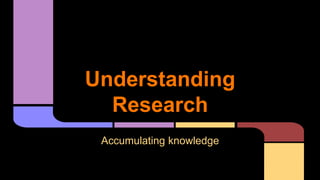Understanding research
•Download as PPTX, PDF•
2 likes•234 views
A slideshow covering different kinds of sources students use in conducting research for essays. Also includes a brief discussion of plagiarism.
Report
Share
Report
Share

Recommended
Recommended
More Related Content
What's hot
What's hot (20)
Name date soci1010 unit 3 touchstone samplecomplete the

Name date soci1010 unit 3 touchstone samplecomplete the
Similar to Understanding research
Similar to Understanding research (20)
Unit 4 LectureDeveloping a ProposalUnit 4 focuses on developi.docx

Unit 4 LectureDeveloping a ProposalUnit 4 focuses on developi.docx
The role of the literature review Your literature review gives y.docx

The role of the literature review Your literature review gives y.docx
Recently uploaded
Recently uploaded (20)
Cambridge International AS A Level Biology Coursebook - EBook (MaryFosbery J...

Cambridge International AS A Level Biology Coursebook - EBook (MaryFosbery J...
Unit 8 - Information and Communication Technology (Paper I).pdf

Unit 8 - Information and Communication Technology (Paper I).pdf
Basic phrases for greeting and assisting costumers

Basic phrases for greeting and assisting costumers
Basic Civil Engineering Notes of Chapter-6, Topic- Ecosystem, Biodiversity G...

Basic Civil Engineering Notes of Chapter-6, Topic- Ecosystem, Biodiversity G...
plant breeding methods in asexually or clonally propagated crops

plant breeding methods in asexually or clonally propagated crops
MARUTI SUZUKI- A Successful Joint Venture in India.pptx

MARUTI SUZUKI- A Successful Joint Venture in India.pptx
aaaaaaaaaaaaaaaaaaaaaaaaaaaaaaaaaaaaaaaaaaaaaaaaaaaaaaa

aaaaaaaaaaaaaaaaaaaaaaaaaaaaaaaaaaaaaaaaaaaaaaaaaaaaaaa
2024.06.01 Introducing a competency framework for languag learning materials ...

2024.06.01 Introducing a competency framework for languag learning materials ...
Instructions for Submissions thorugh G- Classroom.pptx

Instructions for Submissions thorugh G- Classroom.pptx
Understanding research
- 1. Understanding Research Accumulating knowledge
- 2. Types of sources Sources of information can be divided into two types: primary and secondary. Primary sources provide information you collect yourself. Secondary sources make use of information collected by others.
- 3. Primary Sources Interviews and surveys you conduct: Allows you to learn about a topic from experts, but requires preparation and can have a long lead time. You will need to schedule the interview, do background research, formulate questions, conduct the interview and (possibly) follow up for clarification.
- 4. Primary Sources Making Observations: Allows you to experience the topic for yourself. Depending on the topic it might be difficult to observe some things. You need: a clear goal of what you want to accomplish, permission to observe people in areas that are not public, and appropriate means to record your observations.
- 5. Secondary Sources Books: You will be using reference books and nonfiction books. Reference books (encyclopedias etc) cover many topics, but are not detailed. Nonfiction books provide depth, but you need to make sure they are not out of date. Not all authors are recognized authorities and their books will not provide quality information.
- 6. Secondary Sources Periodicals: These are magazines, newspapers and journals. These provide the most up-to-date information, but may not be written by experts in the field. Additionally journals can include technical language and field-related jargon that can be difficult to understand.
- 7. Secondary Sources Web Sites: A favorite of students, the Internet provides easy access to vast amounts of information. However, the sheer load of the information can be overwhelming, some websites are unreliable at best and it’s easy to get distracted while browsing the Web.
- 8. Evaluating Sources Experts and other primary sources: Consider their education and work experience. What qualifies them as an expert. Books and periodicals: Do the authors have the proper background. Are they current? Is the information presented in a fair way.
- 9. Evaluating Sources Broadcasts: If you are using sources from television or radio, consider the show’s intended audience, its sponsors and the broadcaster’s approach. Not all “news” programs are neutral and some work to promote a certain ideology.
- 10. Evaluating Sources Web Sites: Look for the site author and check their credentials. Look at the type of site (.gov, .edu) versus (.com, .biz). Make sure the information is current and that it is presented in a balanced manner.
- 11. Common types of plagiarism Copying Text: Including text passages word for word without giving the author credit. This is lazy, unethical and unacceptable. Use your own words or use “quotes” with proper attribution.
- 12. Common types of plagiarism Forgetting Quotation Marks: Including text passages word for word with credit but no quotes. Not as bad as straight copying, but still wrong. If you use someone else’s words, they must be in quotation marks.
- 13. Common types of plagiarism Restating ideas with citing them. If you restate someone else’s ideas in your own words, you still have to give them credit. Until you take the idea and build it into something new of your own creation, you have to give attribution.
